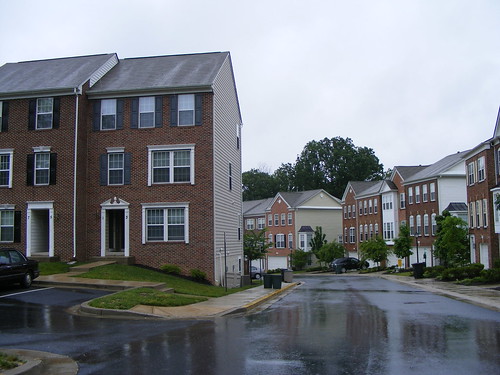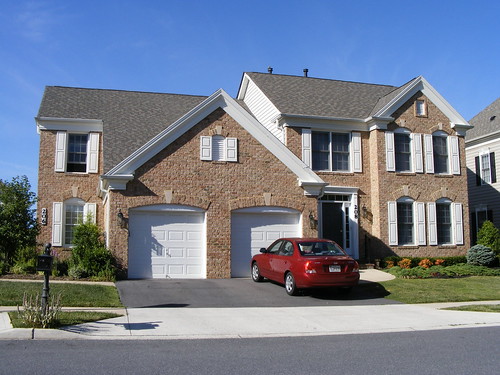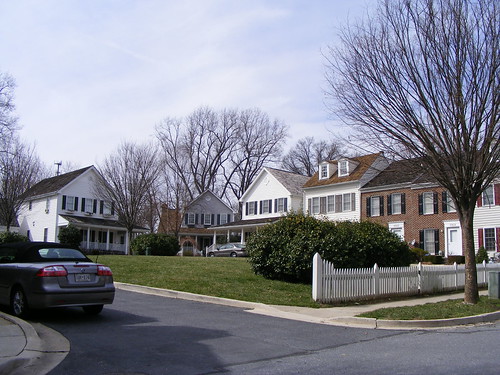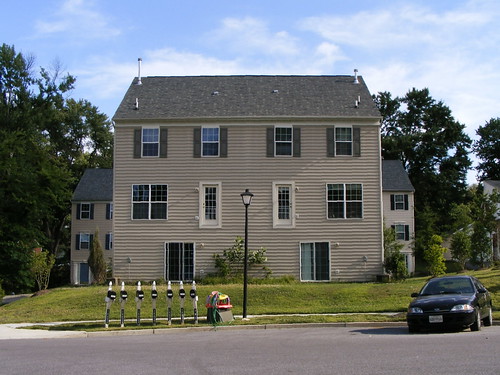My neighborhood of Deer Park has fourteen Moderately Priced Dwelling Units. They're part of Montgomery County's nationally-recognized program requiring new subdivisions to set aside a percentage of units for people of limited means. Bought new in 1993 at market rate by the Housing Opportunities Commission, the county's housing authority, the homes were rented out to families in need. Despite having lived here for ten years, I could not tell you where they are. I know that they're townhouses, but there are far more than fourteen townhouses in my neighborhood. The families who live there look exactly like the families living in the market-rate homes around them. They are inconspicuous, and that's how I - and they - like it.
Many people I've met tend to conflate "affordable housing" with "public housing," and raise concerns - whether from firsthand experience or out of fear - that they bring blight and lower property values. It's hard not to get confused by the many programs the Housing Opportunities Commission operates, from group homes for the disabled to "workforce housing" built for households making less than 120% of Montgomery County's median income, or $120,000 a year. In such an expensive area, a surprisingly broad swath of people have difficulty finding an affordable place to live.
But any proposal to build affordable housing is often contentious, and if built to look cheap, the finished product will stigmatize its residents. If our goal is to create fully integrated neighborhoods, we need to build affordable housing that seamlessly blends into the local context. This can be done by using materials similar to those in more expensive homes, "disguising" the affordable units as larger, more expensive homes, and by mixing them in so as not to create a noticeable "ghetto" within the neighborhood.
The examples below are a mix of owner-occupied units purchased at below-market rates and rentals managed by the Housing Opportunities Commission or, in the case of Fallsgrove, the City of Rockville's housing authority.




In Montgomery County, affordable housing in new development is a fact of life. But nowhere does it say that they should look affordable. Both out of respect to their future occupants, and in deference to often-wary neighborhood associations, those who design and build subsidized housing should make them invisible to the untrained eye. Doing so may seem more expensive, but the value of a stronger, fully integrated community should make the extra cost worth it.
Many people I've met tend to conflate "affordable housing" with "public housing," and raise concerns - whether from firsthand experience or out of fear - that they bring blight and lower property values. It's hard not to get confused by the many programs the Housing Opportunities Commission operates, from group homes for the disabled to "workforce housing" built for households making less than 120% of Montgomery County's median income, or $120,000 a year. In such an expensive area, a surprisingly broad swath of people have difficulty finding an affordable place to live.
But any proposal to build affordable housing is often contentious, and if built to look cheap, the finished product will stigmatize its residents. If our goal is to create fully integrated neighborhoods, we need to build affordable housing that seamlessly blends into the local context. This can be done by using materials similar to those in more expensive homes, "disguising" the affordable units as larger, more expensive homes, and by mixing them in so as not to create a noticeable "ghetto" within the neighborhood.
The examples below are a mix of owner-occupied units purchased at below-market rates and rentals managed by the Housing Opportunities Commission or, in the case of Fallsgrove, the City of Rockville's housing authority.




In Montgomery County, affordable housing in new development is a fact of life. But nowhere does it say that they should look affordable. Both out of respect to their future occupants, and in deference to often-wary neighborhood associations, those who design and build subsidized housing should make them invisible to the untrained eye. Doing so may seem more expensive, but the value of a stronger, fully integrated community should make the extra cost worth it.

3 comments:
I agree with you completely that new "affordable" units should be built to look like the non-subsidized units in new developments.
However, one has to wonder at the fairness of passing on the costs of the subsidized units to the buyers of the non-subsidized units rather than to the population as a whole. Undoubtedly the builders, who are required by law to build the MPDUs, simply raise the price of their other units to recoup their costs and foregone profits.
And if potential buyers want to avoid paying a higher price to subsidize part of their lower income neighbors' housing costs, all they need to do is buy in an older neighborhood without MPDUs. There they pay only for their own house, not their own house and part of another. So rather than the subsidy being paid for by all of us, it is paid for only by a small group.
Come to think of it, maybe that's why the current policy is politically viable; we all can say we are doing something to make housing available to all while the vast majority of us don't have to pay anything to do it!
Fascinating! And I do believe I made the same recommendations/suggestions back in the 2008 Special Elections campaign.
Here's an excerpt:
I wonder, could it be possible to change zoning regulations and the affordable-housing or moderately-priced dwelling units ("MPDU") regulations to require: that if such large buildings are built on lands that previously were semi-rural or mostly undeveloped, one of six such buildings should be zoned for multiple-family occupancy? Thus, if there were six buildings of the size of the one shown above, one of those six could be home to rental tenants or condominium residents.
Of course, I was then running as a Republican, and had to add:
I do not at all suggest that such large buildings with MPDUs be subsidized at taxpayer expense to house the indigent amid the wealthy. I am proposing that such large buildings could house established small working-class families or families of young professionals just embarking on their careers.
But considering the present economic climate, I bet at least some of the homes pictured in that blog posting may be wishing they could rezone and turn their colossal McMansions into a 6-plex and let the renters pay the monthly note.
That would even be in conformance with Dan's suggestion, that you not easily be able to tell by exterior features how many people might be living there, or how divided or sublet the properties might be on the interior.
As long as the yards don't get crapified or the streets overparked, probably nobody would much complain.
Perhaps the state could issue bonds that pay 3% interest. These bonds would be used to provide 4% mortgages for people who meet certain income requirements( those who would be elgible for affordable housing).
This is an idea that was proposed in the U.S. Congress in the early 1980's.
It would alleviate the need for MDPU's and spur a new housing boom which in turn would lead to emplyment for jobs related to the construction industry.
Bob Fustero
Post a Comment